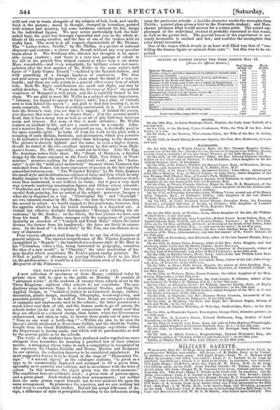THE DEPARTMENT OF SCIENCE AND ART.
A new collection of specimens at Gore House, exhibited today by private view, will be open to the public on Monday. It consists of "advanced works" of the students of twenty-three schools of art in the Three Kingdoms: eighteen other schools do not contribute. The pro- ductions range between Stage 9, or Anatomical Studies, and Stage 23, Applied Design, or "technical studies in architectural design, surface- decoration, plastic design, moulding, lithography, wood-engraving, and porcelain-painting." In the hall of Gore House are arranged a number of examples and implements used in the schools; the latter procured at a much lower cost than of old, and the former made to go off among the schools better (so far as the terms of comparison will stand) now that they are offered at a reduced charge, than before when the Government endeavoured, and often in vain, to bestow them gratis out of pure love. "Doss no one want a bottle-imp ? "-Within are also to be seen the Queen's shield attributed to Benvenuto Cellini, and the shield by Vechte, bought from the Great Exhibition, with electrotype repfititions which the Department is having made, and which will be pnrchaseable as well by the general public as by the schools. The works of the students have been produced under regulations more stringent than heretofore for insuring a practical test of their relative merits; a stringency whose value in such a competition is recognized by the reporters, Sir Charles Eastlake and Messrs. Maclise and Redgrave. In our opinion, the collection deserves to be considered satisfactory. Its most suggestive feature is to be found in the stage of "Elementary De- sign." "A natural object," as the catalogue explains, "is given as a type to be ornamentally displayed and arranged to fill a given form, agreeably as to quantity and contrast, and in accordance with the laws of colour. In this instance, the object given was the wood-anemone." The conditions here are evidently strict ; a given form of pattern-space, and a given plant. Each student sends four arrangements ; yet neither does the same person repeat himself, nor do two students hit upon the same arrangement. So pronounce the reporters, and we saw nothing but what went to confirm their verdict. Beyond the actual difference of de- sign, a difference of style is perceptible according to the influences acting upon the particular schools: a lacelike character marks the examples from Dublin ; painted glass gives a hint to the Newcastle student; and Man- chester produces what would answer for a cotton-print. The actual em- ployment of the individual student is probably concerned in this result, as well as the genius loci. The general lesson of the experiment is cer- tainly favourable to method and law, and confutes the assumption that rules dwarf invention.
One of the stages which struck us as least well filled was that of "mo- dolling the human figure or animals from casts " : but this was to be ex- pected.


























 Previous page
Previous page